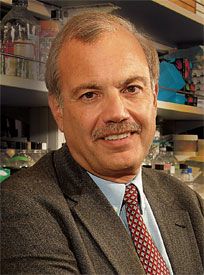PIK3CA/PTEN Linked to Extended PFS in Patients With HER2-Positive Breast Cancer
A recent combined analysis of the BOLERO-1 and -3 studies showed that PIK3CA mutations and low/no expression of PTEN linked to an extension in progression-free survival (PFS) for patients who have metastatic HER2-positive breast cancer and are treated with a combination of everolimus, trastuzumab, and paclitaxel.
Dennis Slamon, MD, PhD

Dennis Slamon, MD, PhD
A recent combined analysis of the BOLERO-1 and -3 studies showed thatPIK3CAmutations and low/no expression of PTEN linked to an extension in progression-free survival (PFS) for patients who have metastatic HER2-positive breast cancer and are treated with a combination of everolimus, trastuzumab, and paclitaxel.
In the combined, next-generation sequencing (NGS)-based analysis, those with alterations inPIK3CA(30.3%) experienced an extension in PFS with everolimus compared with placebo (HR = 0.67; 95% CI, 0.45-1.00; P= .05). However, a benefit was not observed with everolimus in patients with wild-type PIK3CAmutations (HR = 1.1; 95% CI, 0.83-1.45; P= .5).
Similarly, in those with low or a loss of PTEN expression (14.4%), PFS was improved with the addition of everolimus (HR = 0.54; 95% CI, 0.31-0.96;P= .035); whereas those defined as PTEN normal by IHC did not experience any benefit with the addition of everolimus (HR = 1.00; 95% CI, 0.8-1.26; P= .97).
"This is the largest panel that is linked to a therapeutic that's directed at a pathway implicated with response in HER2," Dennis Slamon, MD, PhD, chief of the division of Hematology-Oncology at UCLA, said when he presented the results at the 2015 ASCO Annual Meeting. "BOLERO-1 and BOLERO-3 show consistent patterns in terms of what we see with PTEN expressionPIK3CAmutations and the benefit from the everolimus and trastuzumab-based regimens. There was no benefit showed in either trial for patients without these alterations."
In the phase III BOLERO-1 study, 719 patients with HER2-positive locally advanced or metastatic breast cancer received trastuzumab plus paclitaxel with either everolimus (n = 480) or placebo (n = 239). Patients had not received prior therapy, except endocrine therapy when applicable.
In the full population, the addition of everolimus did not demonstrate a significant extension in median PFS (HR = 0.89; 95% CI, 0.73-1.08;P= .1166). However, in a preplanned analysis of patients with hormone receptor (HR)-negative disease (n = 311), a trend toward a PFS advantage was seen with the addition of everolimus (20.27 vs 13.08 months; HR = 0.66; 95% CI, 0.48-0.91; P= .0049).
In the phase III BOLERO-3 study, 569 patients with HER2-positive locally advanced or metastatic breast cancer received trastuzumab plus vinorelbine with either everolimus (n = 284) or placebo (n = 285). Patients had received prior treatment with a taxane and were resistant to trastuzumab.
In the full population, PFS was moderately extended by the addition of everolimus (media PFS, 7.0 vs 5.78 months; HR = 0.78; 95% CI, 0.65-0.95;P= .0067). In the HR-negative group (n = 250), a greater benefit was observed with the addition of everolimus (HR = 0.65; 95% CI, 0.48-0.87).
"Apart from HER2, there are no other validated biomarkers to predict response to therapy in this subtype," Slamon said. "One of the most frequently altered pathway in HER2-positive breast cancer is the PI3K/AKT/mTOR pathway, and there is significant preclinical data to implicate this pathway."
In the combined biomarker analysis, archival formalin-fixed, paraffin-embedded tumor samples were analyzed using the Illumina HiSeq platform (n = 377), Sanger sequencing (BOLERO-3 only; n = 184), and immunohistochemistry (IHC; n = 506). Mutations uncovered in BOLERO-1 and -3 were comparable with 111 HER2-positive samples analyzed from the TCGA.
The most frequently altered genes were in the FGFR family, PI3K/mTOR pathway, andTP53.TP53alterations were seen in approximately 67.5% of samples (range, 65.1-69.8), PIK3CAin nearly 31% (range, 29.2-32.4), CCND1in around 17% (range, 15.9-18.9), and FGFR1in 11% (range, 9.2-13.2). Of the most commonly altered genes (n = 11), nine were amplification events.
Certain genes were altered more frequently between the HR-negative and -positive groups, includingERBB2,TP53, and those in the FGFR family.FGFR1/ZNF703were altered in 16.7% of patients in the HR-positive arm versus 2.7% of those in the negative arm (P<.001). TP53was mutated in 54.6% of HR-positive tumors versus 86.7% of HR-negative samples (P= .001). CCND1/FGF3.4.19mutations were seen in 22.5% versus 8.7%, for HR-positive and -negative, respectively (P= .001).
In an analysis looking at the entire pathway, PI3K pathway hyperactivity was linked with an extension in PFS with everolimus (HR = 0.67; 95% CI, 0.48-0.93;P= .016). However, alterations in the cell cycle and FGFR pathways did not correlate with PFS.
"This is the first clinical observation that really correlates molecular alterations in the PI3K pathway with everolimus sensitivity," Slamon said. "This may define a HER2-positive advanced breast cancer population who could benefit from this therapy."
Slamon DJ, Hurvitz SA, Chen D, et al. Predictive biomarkers of everolimus efficacy in HER2+ advanced breast cancer: Combined exploratory analysis from BOLERO-1 and BOLERO-3.J Clin Oncol. 2015;33 (suppl; abstr 512).